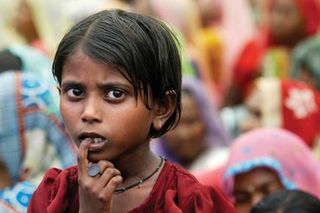Kainaat Mushtaq
SRINAGAR, Nov 9: As the curtains are raised, the sound of thunder echoes through a theatre, a boy is killed in crossfire, head separated from torso and dead men shrouded in white cloth emerge from their graves, to recount details of brutal killings in Kashmir.
Stage plays in the Kashmir valley have traditionally centered on family dramas or heart-rending romance before an armed uprising began in the early nineties. But a recent revival is throwing light on graphic re-enactments of darker events linked to a bloody revolt.
“Theatre, or any art as such, is the mirror of society,” said 45-year-old Mohammad Amin Bhat, a prominent Kashmiri playwright and director.
“It should reflect what is happening.”
A series of over a dozen plays staged on Thursday at S.P College, Srinagar, provided a peep into the past of Kashmir since 1947, when a controversial accession deed to India was signed by the region’s Dogra monarch, till 2010.
At the end of the first day of the two-day seminar on “Kashmiri Drama” organised by Sahitya Akademi in collaboration with Kashmir Theatre Federation, evoked mixed feelings of melancholy and humour.
“There could not have been a better way of recounting the sufferings of Kashmiri people in the last 21 years and saluting them for their resilience than a collage of 12 contemporary plays staged at the packed auditorium,” said a senior journalist, Syed Shujaat Bukhari.
The plays included Ek Potli Armaano Ki – meaning a pouch of desires – depicting the partition of India and Pakistan in 1947, Maya Zaal, showing the elements of corruption in public life and ‘Phritey Muth’ conveying lawlessness in dealing with ordinary incidents of theft.
‘Watch Thavun Chu Zaroor’ depicted political gimmicks, Musafir showed a rat being elevated by the support of strangers to a lion’s position, subtly criticising the popular leader of Kashmir, Sheikh Mohammad Abdullah, who is also known as Sheri Kashmir or the Lion of Kashmir for fighting Dogra monarchy in the state.
Another play, Trunove, identified the crisis in Kashmir, Brunz Brunz Qayamat showed the suffering of the Kashmiris as a result of the conflict, Iteqaam revolved around the killings that took place in Kashmir during the conflict and Watte Paed reflected on the killings during the mass unrest in 2010.
“My effort has been to raise the level of debate, to shape a refined way of protest. That is what the role of stage should be,” said Bhat, who has written and directed at least half a dozen plays on Kashmir’s violence.
He has been inspired by an incident involving his younger brother who was wounded in a grenade attack and bled to death when troops stopped him from being taken to hospital.
‘Real-life dramas’
Nearly 23 years of unrest have left nothing untouched in Kashmir and has brought untold misery to the region and its once easy-going society.
Entertainment was a big casualty.
Srinagar’s lone theatre, Tagore Hall, became a camp for the security forces, putting an end to a rich tradition of plays dealing with local history, folk tales, family dramas, religion and social issues.
Militants forced cinemas to close down and the guerrillas several times targetted cable TV stations blaming them of running what they called were immoral broadcasts.
But stage actors are now treading the boards once again following a considerable decline in separatist violence since India and Pakistan began peace moves in 2004.
“From the past three four years theatre is slowly picking up. I am happy the most important part of our culture has returned,” actor Mohammad Subhan said.
Over a dozen theatre clubs are now up and running.
“There are stories which concern and touch all of us,” said theatre fan Saleem Ahmad after the curtain fell at the end of “White Paper” and hundreds stood up and applauded.
“I am happy theatre is back, to do what it is supposed to do.”










